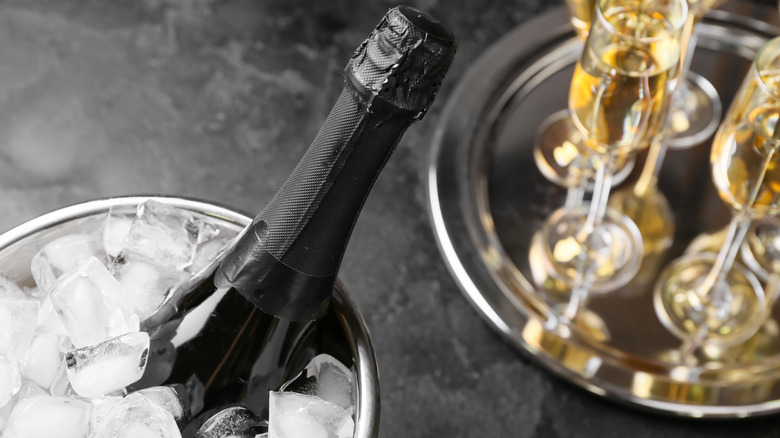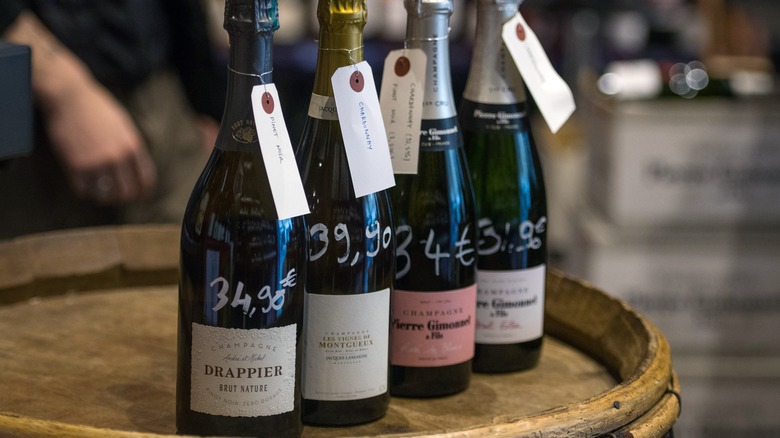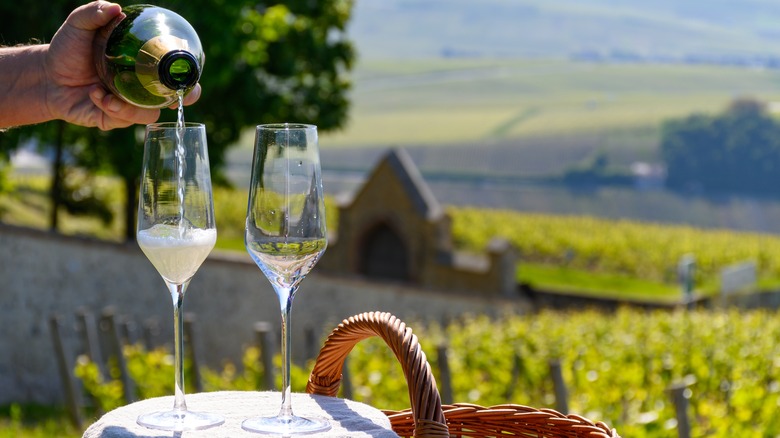How To Pick A Good Bottle Of Champagne Without Breaking The Bank
You can already envision it — the satisfying pop, the enticing fizz, the ceremonial clink. You've got Champagne on your mind, and now all you have to do is decide which one is right for your celebration. Trying to choose a brand of Champagne can definitely be intimidating ... and expensive! To make your life a little more bubbly, Food Republic got some insight on delicious and affordable Champagnes from sommelier Doreen Winkler. She has a passion for natural wines and consults with restaurants, like New York's Mishik, to create robust wine programs.
"I think grower Champagnes are the way to go," says Winkler. Grower Champagne is made by the folks who are actually farming the grapes, which is a different business structure from how most Champagne is made, bottled, and sold. These are smaller batches coming from specific parcels, and the taste of the Champagne really reflects that terroir — the unique land and environment where the grapes are grown. "Often priced moderately, they deliver the best value and, in my humble opinion, taste best," explains Winkler.
The vast majority of Champagnes are made by maisons — large companies that buy grapes from many different farmers and regions. The goal is to create a unified blend that can be consistently replicated — think Moët, Veuve Clicquot, and Dom Pérignon. In a way, grape growers are reclaiming some autonomy and self-expression with grower Champagnes. Winemakers can really get creative and put their specific touch on their products.
How to buy grower Champagne
Champagne terminology can be a bit confusing, but most wine labels will give you a clue. On the front of the bottle, look for the letters "RM" in small print. This stands for Récoltant Manipulant, and means that at least 95% of the fruit was grown on the estate. Brands that feature a single or hyphenated last name are often — though not always — grower Champagnes. Doreen Winkler particularly recommends wines from importers like Louis Dressner Selections, Bowler Wines, and Zev Rovine Selections.
Only about 5% of the Champagne imported into the United States is grower Champagne, so your best bet on getting your hands on a bottle is heading to a specialty shop, a large wine store with a significant selection, or an online retailer. Also, lean into the expertise of your server, sommelier, or shopkeeper. They can help you find what you are looking for and speak to the unique qualities in each bottle.
When it comes to price, Winkler says, "You should spend what you are comfortable with. I have seen great grower Champagne in retail starting at $39[,] but I definitely have splurged on very very special ones for over $100." Remember that a standard 750-milliliter bottle of Champagne contains about six glasses, and consider how much you spend per drink at a restaurant. For a retail bottle, you are looking at as little as $6.50 per glass of bubbly. Large-format magnum Champagne bottles can be even more economical.
What does grower Champagne taste like?
The taste of Champagne can vary widely, ranging from light, vibrant, and mineral-driven to rich, toasty, and honeyed. It may feature notes of citrus, stone fruit, florals, herbs, freshly baked bread, and more. For Doreen Winkler, "minerality and layers of flavor and texture" are among the top qualities she seeks. She also values "beautiful, persistent tiny bubbles that show even with the last drop out of the bottle."
The flavor of the grapes and the resulting wine depends on more than just the varietal. It's deeply influenced by the soil, climate, vinification techniques, and even the specific types of natural yeast present in the environment. Grower Champagne captures a snapshot of all these elements, reflecting the unique style of the producer. To truly appreciate the terroir's characteristics, Winkler recommends opting for Champagnes labeled Brut Nature or Brut Zero, which contain no added sugar, or dosage. Since winemakers aren't aiming to produce an identical product with each vintage, the flavor of the Champagne delightfully varies from year to year. It's akin to enjoying a cool, single-origin brew from a local shop instead of the standard cup from a large coffee chain.



